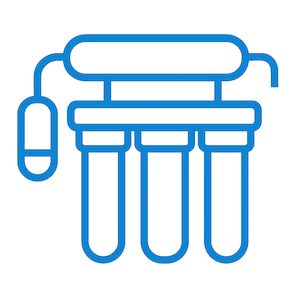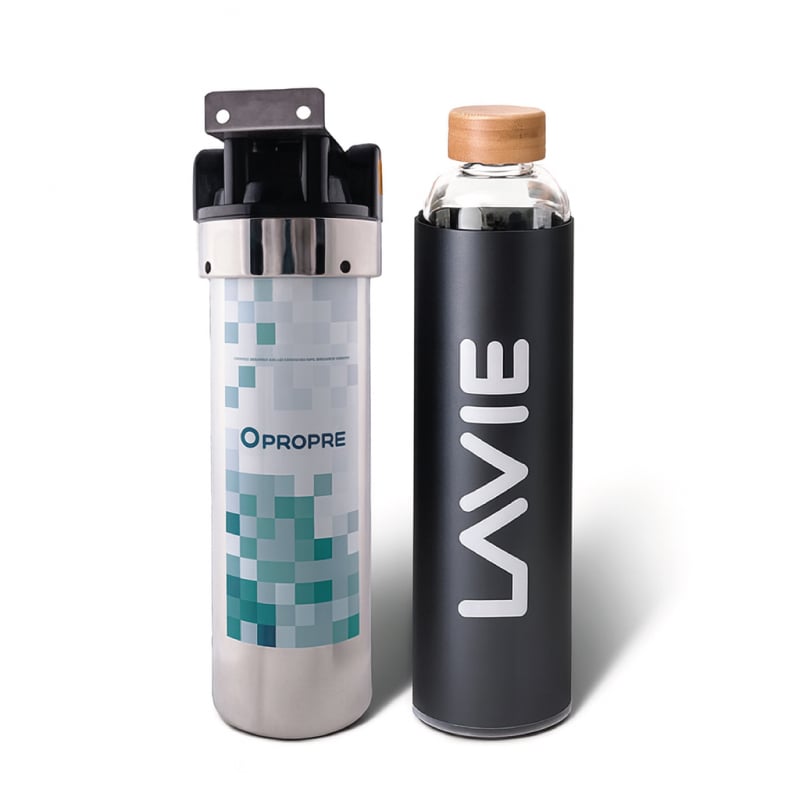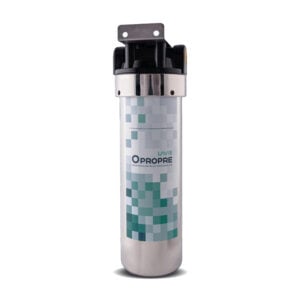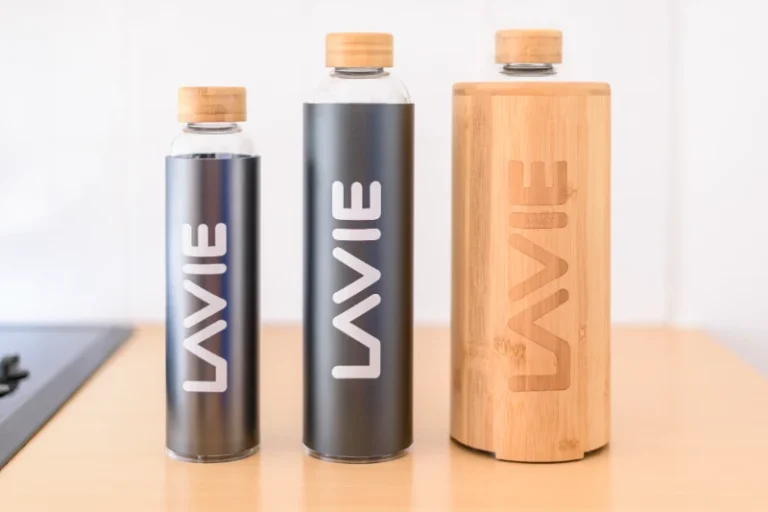
30-day money-back guarantee *
30-day money-back guarantee *

In France, tap water is strictly controlled. But is this enough to make it completely safe? Unfortunately, not always. Its quality depends on many factors The results: the water sometimes contains pesticides, drug residues, bacteria and the infamous PFAS.
July 2025, 12 towns in the Ardennes have even banned its consumption because of high PFAS levels. So can we still trust tap water?
Faced with these concerns, some households are turning to reverse osmosisa radical filtration method capable of eliminating up to 99 % of the contaminants present in drinking water. An attractive solution, but not without consequences: minerals removed, acidity, microbial risk, water wastage, etc.
So is this technology really suitable for everyday use? What are its dangers, and what safer alternatives are there? We take a look.
An osmosis unit is a water treatment device based on the principle of reverse osmosis. It works by means of a semi-permeable membrane that eliminates most pollutants present in the water, blocking dissolved impurities: heavy metals, bacteria, pesticides, organic contaminants and even PFAS.
This is a three-stage process:
This process then produces very pure water at the tap outlet.
Reverse osmosis is considered to be one of the most effective treatment systems on the market. Thanks to its semi-permeable membrane, this system retains up to 99 % of contaminants present in water: heavy metals, nitrates, drug residues, pesticides, PFAS (eternal pollutants), viruses, bacteria, etc.
The result? Highly pure water, virtually free of undesirable substances. It's clearer, odourless, tasteless and visually limpid. That's why many households opt for this solution when they're looking for maximum filtration.
But this extreme purity is not without its complications. L'osmosis plant has several disadvantagesfor both your health and the environment.
Reverse osmosis may impress with its efficiency, but its extreme results are not without risk. By eliminating almost everything, it also deprives the water of certain necessary elements, with negative consequences for the environment. possible adverse effects on your body and the environment.
If you want perfectly pure water, you run the risk of losing its natural properties. essential benefits. Reverse osmosis treatment eliminates virtually all the contaminants present in water, as well as necessary minerals such as calcium, magnesium and potassium. These elements play a key role in the functioning of the body. Their absence can therefore, in the long term, promote deficiencies and alter the quality of hydration.
Another consequence is excessive acidity. Without these alkaline minerals to regulate the pH, treated water becomes more acidic. Consuming it on a daily basis can then unbalance the body, disrupt digestion and weaken certain metabolic functions.
And that's not all! By removing the chlorine naturally present in water, osmosis systems also eliminate its disinfectant power. Result: without regular cleaning of the appliance, this system is a breeding ground for bacteria.
The magazine 60 Millions de consommateurs warns of the harmful effects of this process and states that "we advise against drinking osmosis water"even going so far as to headline: "Osmosis water: a scam and a danger".
Behind its promise of purity, water treatment by osmosis hides a high ecological cost. For every litre of water filtered, it discharges up to 4 litres of water down the drain. The biggest problem? This waste water, known as brineThe water is concentrated in pollutants (heavy metals, pesticides, PFAS, etc.) and goes straight back into the environment. An ecological nonsense!
Unfortunately, it doesn't stop there. To compensate for extreme demineralisation, some machines incorporate a re-mineralisation system. The result: cartridges to buy, replace and dispose of. So many energy-consuming consumables and waste, on top of the high cost of the product, installation and maintenance.
Despite all this, the water remains well below the mineral levels recommended by the WHO, which tap water respects in France.
This raises the question: is it really necessary to filter so much water that is already drinkable? L'osmosis unit for taps ultimately appears to be a costly, unsustainable and environmentally catastrophic solution. Overall, it amounts to manufacturing ultra-processed water that has lost most of its original qualities.
Read also : Water osmosis: why isn't this device so essential?
Reverse osmosis may be attractive because of its performance, but it is restrictive, expensive and disastrous for the environment. Fortunately, LAVIE offers innovative, healthier appliances and more respectful of your body and the planet.
UV-A filter jug, Opropre under-sink filter... A responsible solution for every need.
|
Element filtered, reduced or eliminated |
Classic carafe filter |
Tap filter |

Osmosis unit |

Opropre under-sink filter |

LAVIE Purifier |

Peace of mind pack (Opropre + LAVIE PURE) |
| Chlorine | ✅ | ✅ | ✅ | ✅ | ✅ | ✅ |
| Sediment | ✅ | 🟠 | ✅ | ✅ | ❌ | ✅ |
| Bacteria | ❌ | ❌ | ❌ | ❌ | ✅ | ✅ |
| Virus | ❌ | ❌ | ❌ | ❌ | ✅ | ✅ |
| Medicines | ❌ | ❌ | ✅ | ✅ | ✅ | ✅ |
| Pesticides | ❌ | ❌ | ✅ | ✅ | ✅ | ✅ |
| Heavy metals | 🟠 | 🟠 | ✅ | ✅ | ❌ | ✅ |
| PFAS | ❌ | ❌ | ✅ | ✅ | ❌ | ✅ |
| Microplastics | ❌ | ❌ | ✅ | ✅ | ❌ | ✅ |
| Mineral conservation beneficial |
❌ | 🟠 | ❌ | ✅ | ✅ | ✅ |
| Discover | Discover | Discover |
Le Opropre Turquoise under-sink filter offers a high-performance, long-lasting solution that's kind to your body. Its technology is based on activated coconut carbon, which effectively eliminates heavy metals, pesticides and microplastics. while preserving essential trace elements your body's balance.
Opropre Turquoise incorporates an ion exchange resin that targets the most stubborn pollutants, such as PFAS.
What's more, its innovative design is based on a returnable, refillable and 100 % recyclable cartridge and resin, to be returned to LAVIE every 6 months. The result: no disposable plastic, less waste and zero water discharges.
Easy to install under the sink, these filters are an ecological and effective alternative that preserve the natural quality of the water.

Much more effective than a conventional carafe, the LAVIE UV-A carafe is based on patented UV-A light technology, which eliminates chlorine, pesticides, drug residues and certain bacteria and viruses in 15 minutes, while also preserving the minerals essential to your body. With no filters or cartridges to change, it generates no plastic waste or water wastage.
Combined with an Opropre under-sink filter, it forms a formidable duo for your home. While Opropre blocks heavy metals, microplastics, pesticides and PFAS upstream, the UV-A filter carafe completes the action by neutralising invisible residues and other impurities. An ideal combination for deeply purified, balanced water that's good for your health.
And for families, offices or local authorities, LaFontaine treats up to 5 litres of tap water in a single step.
With LAVIE, you can purify your water without depleting it, without polluting it and without compromising your well-being.

Long considered a practical and safe solution, bottled water is neither a sustainable nor a genuinely healthy alternative to reverse osmosis. It generates massive plastic pollution, has a high carbon footprint due to transport and costs much more than home-filtered water.
Not forgetting the proven presence of microplastics in certain bottled waters, which raises real health concerns.
In other words, if reverse osmosis is not idealNeither is bottled water good for your body or for the planet.
Osmosis water is water filtered using the reverse osmosis process. This technology uses a semi-permeable membrane to remove up to 99 % of contaminants. The result is water that is very pure, but also depleted in essential minerals. Which poses certain health risks.
Drinking water treated by an osmosis machine is not recommended in the long term. Too purified, it is demineralised: it no longer contains calcium, magnesium or potassium. These are all elements that the body needs. What's more, its acidity can upset the body's pH, leading to metabolic imbalances and disorders.
Water treatment using reverse osmosis has a number of disadvantages:
- It eliminates good minerals, making the water too acidic.
- It discharges between 2 and 4 litres of polluted water for every 1 litre purified.
- It requires complex installation and regular maintenance.
- Without chlorine, water becomes vulnerable to bacteria.
This is a costly, restrictive and environmentally unfriendly method.
Softened water is used above all to protect installations against limescale, by reducing water hardness. Osmosis water, on the other hand, is ultra-filtered to eliminate as many contaminants as possible. Two different systems, then, with distinct purposes: one for household appliances, the other to obtain very pure water.
Want to keep up to date with our water-related articles?
Subscribe to our Newsletter below
and get -5% on your first order!